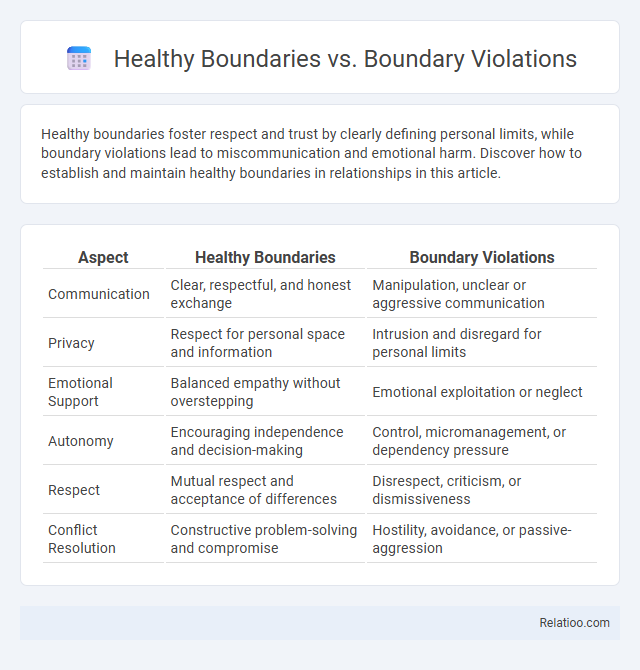Healthy boundaries foster respect and trust by clearly defining personal limits, while boundary violations lead to miscommunication and emotional harm. Discover how to establish and maintain healthy boundaries in relationships in this article.
Table of Comparison
| Aspect | Healthy Boundaries | Boundary Violations |
|---|---|---|
| Communication | Clear, respectful, and honest exchange | Manipulation, unclear or aggressive communication |
| Privacy | Respect for personal space and information | Intrusion and disregard for personal limits |
| Emotional Support | Balanced empathy without overstepping | Emotional exploitation or neglect |
| Autonomy | Encouraging independence and decision-making | Control, micromanagement, or dependency pressure |
| Respect | Mutual respect and acceptance of differences | Disrespect, criticism, or dismissiveness |
| Conflict Resolution | Constructive problem-solving and compromise | Hostility, avoidance, or passive-aggression |
Understanding Healthy Boundaries
Understanding healthy boundaries involves recognizing clear limits that protect your emotional well-being while respecting others' autonomy, fostering mutual trust and effective communication. Boundary violations occur when these limits are ignored or disrespected, leading to emotional harm and diminished relationships. Maintaining healthy boundaries enhances personal empowerment and prevents boundary violation patterns that undermine your mental health.
Common Types of Boundaries
Healthy boundaries include physical, emotional, intellectual, and time boundaries that respect personal space and individual needs. Boundary violations occur when these limits are crossed without consent, often manifesting as invading privacy, emotional manipulation, or disrespecting personal time. Boundary violation refers specifically to the act or instance of overstepping these lines, commonly seen in cases of harassment, coercion, or ignoring expressed limits.
Signs of Healthy Boundaries
Healthy boundaries are evident when you maintain clear limits that protect your emotional well-being and foster mutual respect in relationships. Signs include the ability to say no without guilt, communicating your needs assertively, and recognizing when others respect your space and feelings. Distinguishing healthy boundaries from boundary violations involves understanding that violations occur when these limits are ignored, causing discomfort or harm.
What are Boundary Violations?
Boundary violations occur when personal limits are ignored or crossed, resulting in harm or discomfort to one party. These violations can manifest as emotional manipulation, physical intrusion, or disrespecting privacy, undermining trust and safety in relationships. Understanding what constitutes boundary violations helps you protect your well-being and maintain healthy interactions.
Examples of Boundary Violations
Examples of boundary violations include consistently ignoring Your personal limits, invading Your physical space without permission, or pressuring You to share private information. Healthy boundaries respect emotions, time, and personal values, while boundary violations cause discomfort, resentment, or harm. Recognizing these violations helps You maintain respectful and safe relationships.
Emotional Impact of Overstepped Boundaries
Healthy boundaries establish clear limits that protect emotional well-being and foster respectful relationships. Boundary violations occur when these limits are ignored, leading to feelings of vulnerability, stress, and decreased self-esteem. The emotional impact of boundary violations often includes anxiety, resentment, and a compromised sense of safety, highlighting the importance of recognizing and maintaining personal boundaries.
How to Recognize Boundary Crossings
Recognizing boundary crossings involves understanding the difference between healthy boundaries, boundary violations, and boundary crossing behaviors. Healthy boundaries respect personal space, emotional limits, and consent, while boundary violations occur when these limits are ignored or intentionally breached, causing harm or discomfort. Boundary crossings often represent mild or unintentional transgressions that signal the need for communication and adjustment before escalating into full violations.
Setting and Maintaining Healthy Boundaries
Setting and maintaining healthy boundaries involves clearly defining personal limits to protect emotional well-being and promote respectful interactions. Boundary violations occur when these limits are ignored or disrespected, leading to discomfort, stress, or harm in relationships. Consistent enforcement of healthy boundaries fosters trust, self-respect, and mutual understanding, preventing boundary violations and enhancing overall mental health.
Communicating Boundaries Effectively
Communicating boundaries effectively requires clear, assertive language that respects personal limits while fostering mutual understanding, preventing boundary violations such as emotional manipulation or invasion of privacy. Healthy boundaries involve setting explicit expectations and consistently reinforcing them to avoid frequent boundary violations that can damage relationships and trust. Recognizing subtle signs of a boundary violation allows individuals to address concerns promptly and restore respectful interactions.
Rebuilding Trust After Boundary Violations
Healthy boundaries establish clear limits that protect your emotional well-being and foster mutual respect. Boundary violations occur when these limits are disregarded, causing trust to erode and emotional harm to arise. Rebuilding trust after boundary violations requires consistent communication, accountability, and a commitment to honoring those boundaries moving forward.

Infographic: Healthy Boundaries vs Boundary Violations
 relatioo.com
relatioo.com